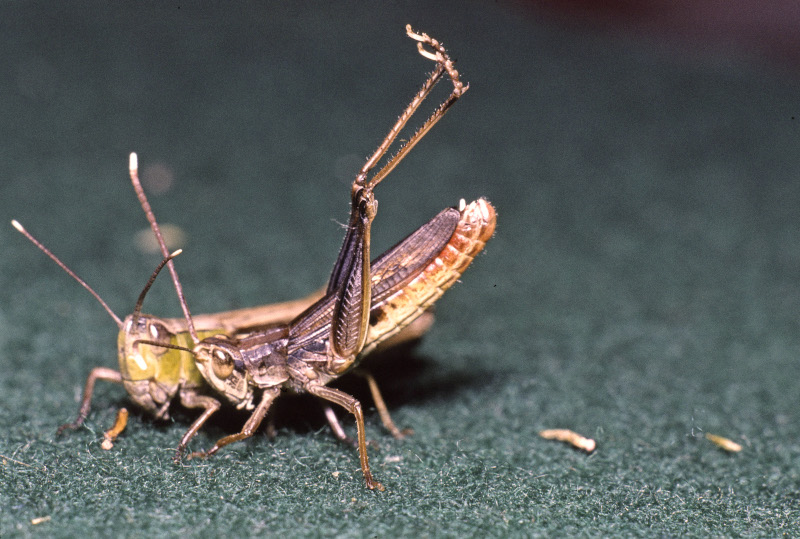
Epirus Dancing Grasshopper Facts
- This remarkable invertebrate most frequently goes by the unusual yet descriptive common name of the Epirus Dancing Grasshopper. It does have a few other general titles it’s knkown by, though. These include the very similar terms of Lake Grasshopper and Lake Chorthippus.
- Inside of scientific circles, however, it’s perhaps much better known by its technical moniker. Unfortunately, that’s a somewhat difficult one for the layperson to pronounce properly. That’s because the amazing Arthropod now holds the official epithet Chorthippus lacustris.
- This wonder of Nature received that designation due to the tireless efforts of Carl Peter Thunberg. The respected Swedish naturalist accomplished the first acknowledgement of it as a separate and distinct species. He achieved that scientifically noteworthy deed in the year 1815.
- Sadly, the highly unique Epirus Dancing Grasshopper now finds itself in dire peril. Researchers currently know of only five small concentrations of the natural wonder. Accordingly, the IUCN thus now ranks the insect as Critically Endangered on its Red List of Threatened Species.
- The rarely photographed invertebrate currently faces multiple threats to its continued existence as a species. Like most forms of life on earth today, most of those stem from the actions of mankind. Broadly, these include the dangers of habitat loss and climate change.
- Yet, this remarkable grasshopper also faces other, more individual threats that apply somewhat more specifically to its particular, local situation. These dangers include deforestation and urbanization. Drainage, intensive cattle grazing and land conversion also endanger it.
Related Articles
Epirus Dancing Grasshopper Physical Description
The fascinating Epirus Dancing Grasshopper typically captivates those individuals fortunate enough to encounter one of these smal marvels. The species general does so, however, due more to its intricate courtship dances. These also understandably serve as the source of its common name.
Regarding its physical characteristics, however, the insect follows a pattern common among its many kindred around the globe. Tht’s in the fact that it displays a certain degree of the physiological trait of sexual dimorphism. It manifests this principle in a wide variety of ways, though.
In overall terms, this example of its kind represents a roughly average-sized grasshopper. Between them, however, females typically achieve a slightly greater size than males. They reach a mean body length of about 0.8 – 1.0 in (2 – 2.5 cm). Males, meanwhile, only average 0.6 – 0.8 in ( 1.5 – 2 cm).
The two genders also typically differentiate themselves quite significantly in terms of body bulk. Females of the species tend to have a much more robust and broader abdomen compared to that of the slimmer one of the males. This evolved to accommodate the many eggs they carry.
Like most of its kind across the globe, the hind legs developed as quite strong, being well adapted for jumping. The antennae also grow long and thread-like, aiding in sensory perception. Those of the males also generally develop as noticeably longer than those of their female counterparts.
The coloring of the Epirus Dancing Grasshopper evolved to allow the creature to blend into its varied surroundings. This primarily consists of random combinations of brownish and greenish shades. Separating the sexes once again, the males usually display much more vivid colors.
Unlike some others among its numerous relatives, the marvel of evolution additionally has very well-developed wings. In coloring, these appear as either a brown or slightly green. A shield-like structure also appears behind the insect’s head. This often presents a slightly raised ridge, as well.
- Kingdom: Animalia
- Phylum: Arthropoda
- Class: Insecta
- Order: Orthoptera
- Family: Acrididae
- Genus: Chorthippus
- Species: C. lacustris
Epirus Dancing Grasshopper Distribution, Habitat, and Ecology
Sadly, the impressive Epirus Dancing Grasshopper apparently evolved as native solely to an extremely restricted region of the earth’s surface. Just how limited in size this zone of habitation is might surprise some of you. For now, no evidence exists that it ever lived anywhere else, either.
The amazing Arthropod developed as endemic to a remarkably tiny section of the continent of Europe. Within that greater region, its native range appears only within the borders of the countries of Greece and Albania. The former represents the majority of that natural territory.
A large part of its difficulties springs from the fact that it possesses highly specialized needs regarding its choice of habitat. The intriguing grasshopper only inhabits very specific types of environments that provide the necessary resources and conditions to ensure its survival.
These factors include areas that remain highly saturated with water, either permanently or seasonally, such as wetlands. Those provide ample vegetation and moisture, which it needs. Others include lakeshores. These areas often have a mix of grasses and other vegetation that it needs.
It also favors areas regularly waterlogged, and it’s often found near lakes and rivers. Since marshes have soft, wet soil and abundant plant life, these locations create an ideal environment for it. Dense stands of reeds that grow in wetland areas also serve as another frequently favored site.
As its multitudinous relatives, the Epirus Dancing Grasshopper evolved as herbivorous in nature. It thus feeds on various grasses and other low vegetation found in its wetland habitats. It also plays a role in controlling plant growth and contributing to the nutrient cycle in its native habitat.
Females also lay their eggs in the soil or plant material, and in great numbers. Both of these settings require highly specific moisture conditions to allow the eggs to develop properly, too. The eggs later hatch into nymphs, which then go through several molts before reaching their adulthood.
Species Sharing Its Range
Check out our other articles on 5 Fabulous South American Lakes, Japanese Dwarf Flying Squirrel, Mount Jade, Jumping Cholla, Axolotl, Powder Blue Damselfly, Fire Salamander, Black Mamba
